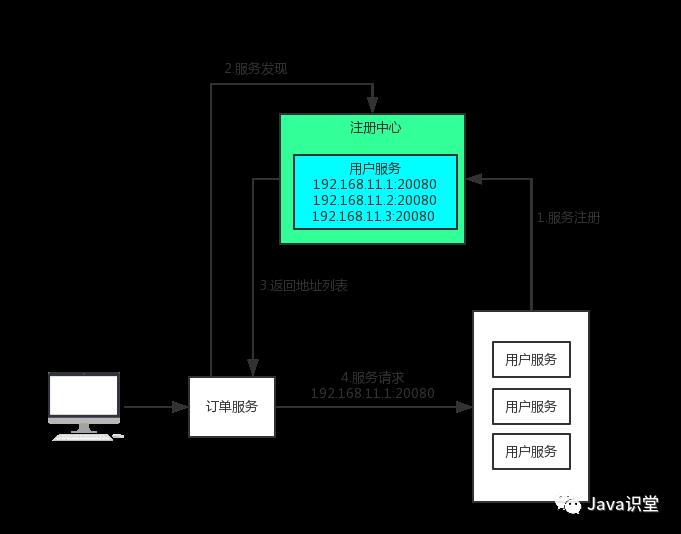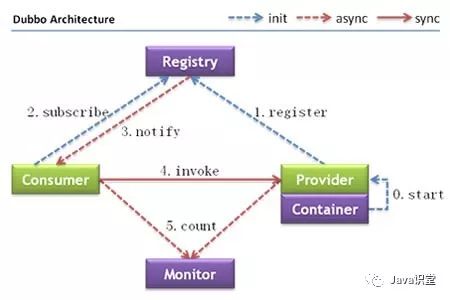图解Dubbo和ZooKeeper是如何协同工作的?
Posted Java识堂
tags:
篇首语:本文由小常识网(cha138.com)小编为大家整理,主要介绍了图解Dubbo和ZooKeeper是如何协同工作的?相关的知识,希望对你有一定的参考价值。
微服务是最近比较火的概念,而微服务框架目前主流的有Dubbo和Spring Cloud,两者都是为了解决微服务遇到的各种问题而产生的,即遇到的问题是一样的,但是解决的策略却有所不同,所以这2个框架经常拿来比较。没用过Dubbo的小伙伴也不用担心,其实Dubbo还是比较简单的,看完本文你也能掌握一个大概,重要的不是代码,而是思想。
服务提供者
定义服务接口
public interface DemoService {
String sayHello(String name);
}
在服务提供方实现接口
public class DemoServiceImpl implements DemoService {
@Override
public String sayHello(String name) {
return "Hello " + name;
}
}
用 Spring 配置声明暴露服务
provider.xml(省略了beans标签的各种属性)
<?xml version="1.0" encoding="UTF-8"?>
<beans>
<!-- 当前项目在整个分布式架构里面的唯一名称,用于计算依赖关系 -->
<dubbo:application name="helloworld-app" />
<!--dubbo这个服务所要暴露的服务地址所对应的注册中心,N/A为不使用注册中心-->
<dubbo:registry address="N/A"/>
<!--当前服务发布所依赖的协议;webserovice、Thrift、Hessain、http-->
<dubbo:protocol name="dubbo" port="20880"/>
<!--服务发布的配置,需要暴露的服务接口-->
<dubbo:service interface="com.st.DemoService"
ref="demoService"/>
<!--bean的定义-->
<bean id="demoService" class="com.st.DemoServiceImpl"/>
</beans>
加载 Spring 配置
public class Provider {
public static void main(String[] args) throws Exception {
ClassPathXmlApplicationContext context = new ClassPathXmlApplicationContext("provider.xml");
context.start();
System.in.read(); // 按任意键退出
}
}
服务消费者
consumer.xml
<?xml version="1.0" encoding="UTF-8"?>
<beans>
<!-- 消费方应用名,用于计算依赖关系,不是匹配条件,不要与提供方一样 -->
<dubbo:application name="consumer-of-helloworld-app"/>
<dubbo:registry address="N/A"/>
<!-- 生成远程服务代理,可以和本地bean一样使用demoService -->
<dubbo:reference id="demoService" interface="com.st.DemoService"
url="dubbo://localhost:20880/com.st.DemoService"/>
</beans>
加载Spring配置,并调用远程服务
public class Consumer {
public static void main(String[] args) throws Exception {
ClassPathXmlApplicationContext context = new ClassPathXmlApplicationContext("consumer.xml");
context.start();
// 获取远程服务代理
DemoService demoService = (DemoService)context.getBean("demoService");
// 执行远程方法
String hello = demoService.sayHello("world");
// Hello world
System.out.println( hello );
}
}
这就是典型的点对点的服务调用。当然我们为了高可用,可以在consumer.xml中配置多个服务提供者,并配置响应的负载均衡策略
配置负载均衡策略在comsumer.xml的<dubbo:reference>标签中增加loadbalance属性即可,值可以为如下四种类型
RoundRobin LoadBalance,随机,按权重设置随机概率。
RoundRobin LoadBalance,轮询,按公约后的权重设置轮询比率。
LeastActive LoadBalance,最少活跃调用数,相同活跃数的随机,活跃数指调用前后计数差。
ConsistentHash LoadBalance,一致性 Hash,相同参数的请求总是发到同一提供者。
<dubbo:reference id="demoService" interface="com.st.DemoService"
url="dubbo://192.168.11.1:20880/com.st.DemoService;
dubbo://192.168.11.2:20880/com.st.DemoService;
dubbo://192.168.11.3:20880/com.st.DemoService"
loadbalance="roundrobin"/>
现在整体架构是如下图(假设服务消费者为订单服务,服务提供者为用户服务):
这样会有什么问题呢?
当服务提供者增加节点时,需要修改配置文件
当其中一个服务提供者宕机时,服务消费者不能及时感知到,还会往宕机的服务发送请求
这个时候就得引入注册中心了
Dubbo目前支持4种注册中心,(multicast zookeeper redis simple) 推荐使用Zookeeper注册中心,本文就讲一下用zookeeper实现服务注册和发现(敲黑板,又一种zookeeper的用处),大致流程如下

现在我们来看Dubbo官网对Dubbo的介绍图,有没有和我们上面画的很相似

节点角色说明
|
节点 |
角色说明 |
|
Provider |
暴露服务的服务提供方 |
|
Consumer |
调用远程服务的服务消费方 |
|
Registry |
服务注册与发现的注册中心 |
|
Monitor |
统计服务的调用次数和调用时间的监控中心 |
|
Container |
服务运行容器 |
调用关系说明
服务容器负责启动(上面例子为Spring容器),加载,运行服务提供者。
服务提供者在启动时,向注册中心注册自己提供的服务。
服务消费者在启动时,向注册中心订阅自己所需的服务。
服务消费者和提供者,在内存中累计调用次数和调用时间,定时每分钟发送一次统计数据到监控中心。
要使用注册中心,只需要将provider.xml和consumer.xml更改为如下
<!--<dubbo:registry address="N/A"/>-->
<dubbo:registry protocol="zookeeper" address="192.168.11.129:2181"/>
<dubbo:registry protocol="zookeeper" address="192.168.11.129:2181,192.168.11.137:2181,192.168.11.138:2181"/>
把consumer.xml中配置的直连的方式去掉
<!-- 生成远程服务代理,可以和本地bean一样使用demoService -->
<!--<dubbo:reference id="demoService" interface="com.st.DemoService"-->
<!--url="dubbo://localhost:20880/com.st.DemoService"/>-->
<dubbo:reference id="demoService" interface="com.st.DemoService"/>
启动上面服务后,我们观察zookeeper的根节点多了一个dubbo节点及其他,图示如下

其实一个zookeeper集群能被多个应用公用,如小编Storm集群和Dubbo配置的就是一个zookeeper集群,为什么呢?因为不同的框架会在zookeeper上建不同的节点,互不影响。如dubbo会创建一个/dubbo节点,storm会创建一个/storm节点,如图
推荐阅读:
Java识堂
以上是关于图解Dubbo和ZooKeeper是如何协同工作的?的主要内容,如果未能解决你的问题,请参考以下文章